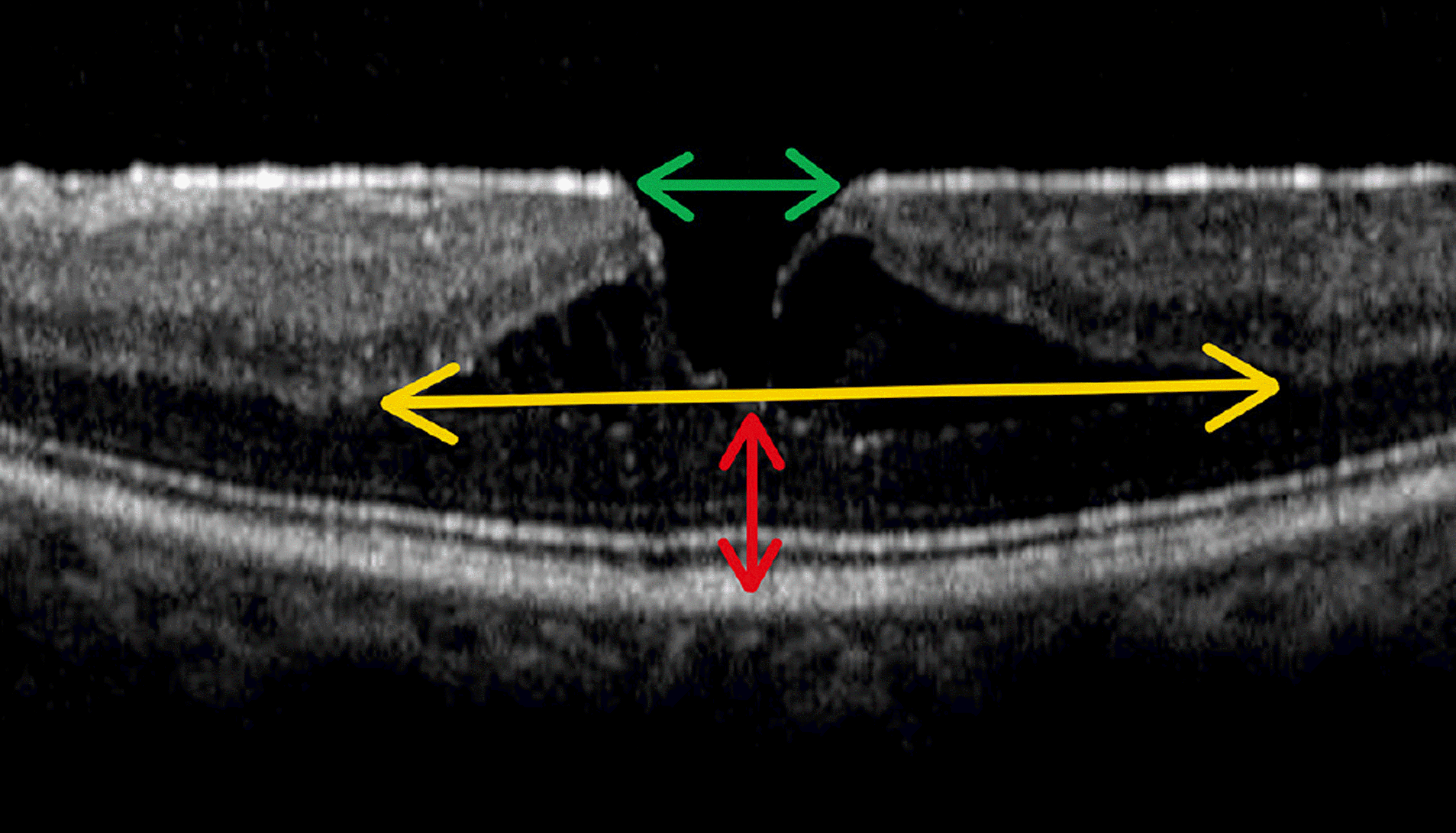Abstract
Methods
This study included 18 eyes of 18 patients with lamellar macular hole who reported visual acuity loss or distorted vision. All patients underwent vitrectomy, epiretinal membrane removal and internal limiting membrane peeling. Intravitreal gas tamponade was performed only in 8 eyes of 8 patients. The patients were divided into 2 groups: 8 eyes in the gas tamponade with vitrectomy group and 10 eyes that did not receive gas tamponade in the control group. The best-corrected visual acuity (BCVA) and appearance based on optical coherence tomography (OCT) were obtained retrospectively.
Results
Epiretinal membranes were observed in all cases. Average visual acuity of the gas tamponade group improved from log MAR 0.50 ± 0.24 to log MAR 0.25 ± 0.14 ( p = 0.041). In the control group, average visual acuity improved from log MAR 0.53 ±0.36 to log MAR 0.32 ± 0.28 ( p = 0.041), however, no significant difference was observed in visual acuity between the 2 groups ( p = 0.584). Anatomical closure or normalized foveal contour after surgery was confirmed in 6 of 8 eyes in the gas tamponade group and in 7 of 10 eyes in the control group. No significant difference between the 2 groups was observed ( p = 1.00).
Go to : 
References
1. Gass JD. Lamellar macular hole: a complication of cystoid macular edema after cataract extraction: a clinicopathologic case report. Trans Am Opthalmol Soc. 1975; 73:231–50.
2. Witkin AJ, Ko TH, Fujimoto JG. . Redefining lamellar holes and the vitreomacular interface: an ultrahigh-resolution optical co-herence tomography study. Ophthalmology. 2006; 113:388–97.

3. Androudi S, Stangos A, Brazitikos PD. Lamellar macular holes: to-mographic features and surgical outcome. Am J Ophthalmol. 2009; 148:420–6.

4. Takahashi H, Kishi S. Tomographic features of a lamellar macular hole formation and a lamellar hole that progressed to a full-thick-ness macular hole. Am J Ophthalmol. 2000; 130:677–9.

5. Casparis H, Bovey EH. Surgical treatment of lamellar macular hole associated with epimacular membrane. Retina. 2011; 31:1783–90.

6. Garretson BR, Pollack JS, Ruby AJ. . Vitrectomy for a sympto-matic lamellar macular hole. Ophthalmology. 2008; 115:884–6.

7. Kokame GT, Tokuhara KG. Surgical management of inner lamellar macular hole. Ophthalmic Surg Lasers Imaging. 2007; 38:61–3.

8. Witkin AJ, Castro LC, Reichel E. . Anatomic and visual out-comes of vitrectomy for lamellar macular holes. Ophthalmic Surg Lasers Imaging. 2010; 41:418–24.

9. Hirakawa M, Uemura A, Nakano T, Sakamoto T. Pars plana vi-trectomy with gas tamponade for lamellar macular holes. Am J Ophthalmol. 2005; 140:1154–5.

10. Chen J, Lee L. Clinical applications and new developments of opti-cal coherence tomoraphy: an evidence-based review. Clin Exp Optom. 2007; 90:317–35.
11. Michalewska Z, Michalewski J, Odrobina D. . Surgical treat-ment of lamellar macular holes. Graefes Arch Clin Exp Ophthalmol. 2010; 248:1395–400.

12. Bovey EH, Uffer S, Achache F. Surgery for epimacular membrane: impact of retinal internal limiting membrane removal on functional outcome. Retina. 2004; 24:728–35.
13. Brooks HL Jr. Macular hole surgery with and without internal lim-iting membrane peeling. Ophthalmology. 2000; 107:1939–48. dis-cussion 1948-9.

Go to : 
 | Figure 1.Preoperative parameters of spectral-domain optical coherence tomography. The green arrow indicates the opening diameter of the lamellar macular hole; the yellow arrow in-dicates the internal splitting of the lamellar macular hole; the red arrow indicates the foveal outer retina thickness at the base from the internal limiting membrane to the posterior boundary of the cone outer segment tip line. |
 | Figure 2.Changes in the foveal contour after surgery. Case 1: (A) Preoperative fundus photograph shows a lamellar macular hole (LMH). (B) Postoperative fundus photograph does not show any apparent LMH. (C) Preoperative spec-tral-domain optical coherence tomography (SD-OCT) shows a LMH. (D) Postoperative SD-OCT shows a regular fo-veal contour. Case 8: (E) Preoperative fundus photograph shows a LMH. (F) Postoperative fundus photograph shows the reddish appearance of the oval-shaped fovea. (G) Preoperative SD-OCT shows a LMH. (H) Postoperative SD-OCT shows a foveal appearance resembling a pseudohole. |
Table 1.
Patient's demographic indices
| Total | Gas∗ | No gas† | p-value | |
|---|---|---|---|---|
| Age (years) | 61.22 ± 8.08 | 60.38 ± 8.37 | 61.90 ± 8.23 | 0.722‡ |
| Male:female | 5:13 | 4:4 | 1:9 | 0.06§ |
| Preop VA (log MAR) | 0.52 ± 0.31 | 0.50 ± 0.24 | 0.53 ± 0.36 | 0.928‡ |
| Opening diameter (μ m) | 451.22 ± 212.48 | 530.13 ± 208.96 | 388.10 ± 203.37 | 0.214‡ |
| Internal splitting (μ m) | 991.33 ± 410.65 | 888.88 ± 270.42 | 1,073.30 ± 494.83 | 0.657‡ |
| Foveal outer retina thickness at the base (μ m) | 134.50 ± 25.05 | 131.50 ± 17.59 | 136.90 ± 30.50 | 0.35‡ |
| Preop CMT (μ m) | 466.89 ± 193.74 | 461.37 ± 182.17 | 471.30 ± 212.22 | 0.79‡ |
| Lens status | Phakic 18 | Phakic 8 | Phakic 10 | |
| Concurrent phacoemulsification | 16 | 7 | 9 | 0.867§ |
| Vitrectomy gauge 20:23 | 5:13 | 2:6 | 3:7 | 0.814§ |
| Dye (ICG + TA:ICG:TA) | 4:7:7 | 1:4:3 | 3:3:4 | 0.58§ |
| Mean follow up (months) | 14.5 ± 11.41 | 20.13 ± 14.4 | 10 ± 5.8 | 0.09‡ |




 PDF
PDF ePub
ePub Citation
Citation Print
Print


 XML Download
XML Download